Small Locks, The Watery Crucible
Elevator of Anxiety
Few things induce anxiety in Pacific Northwest boaters like the Hiram M. Chittenden (Ballard) Locks. Maybe its the salty lock masters scolding skipper and crew. Maybe its that the lock master always directs a boat to tie up on the side opposite the one the crew has prepared, causing a last minute scramble to retie everything as the boat cruises down a death-star-like concrete canal. Maybe its other boaters’ lack of control and propensity to ram other vessels. Maybe its the very real possibility of being turned by the flow of the water current and wedged into the locks like the Evergiven in the Suez canal.
Whatever it is, my locking anxiety had almost entirely abated after years of practice. The only exceptions are the really busy summer days with long lines of boats waiting to return to the lake. On these days, we have to sneak into the narrow space in front of the often closed railroad bridge to wait in line. We have to deal with motor boaters thinking we’re cutting in line. Them not appreciating that our mast, the bridge and the strong currents create a very real risk of getting sucked under, then wedged under the bridge. Them not appreciating that if we are stuck on the wrong side of the bridge, we may have to wait for many hours. Except for those days, I was pretty comfortable with the locks.
Railroad bridge at the locks
With the bridge down, sailboats are shut into a small space. The water current from the locks and boat traffic can make this a tricky place to maneuver.
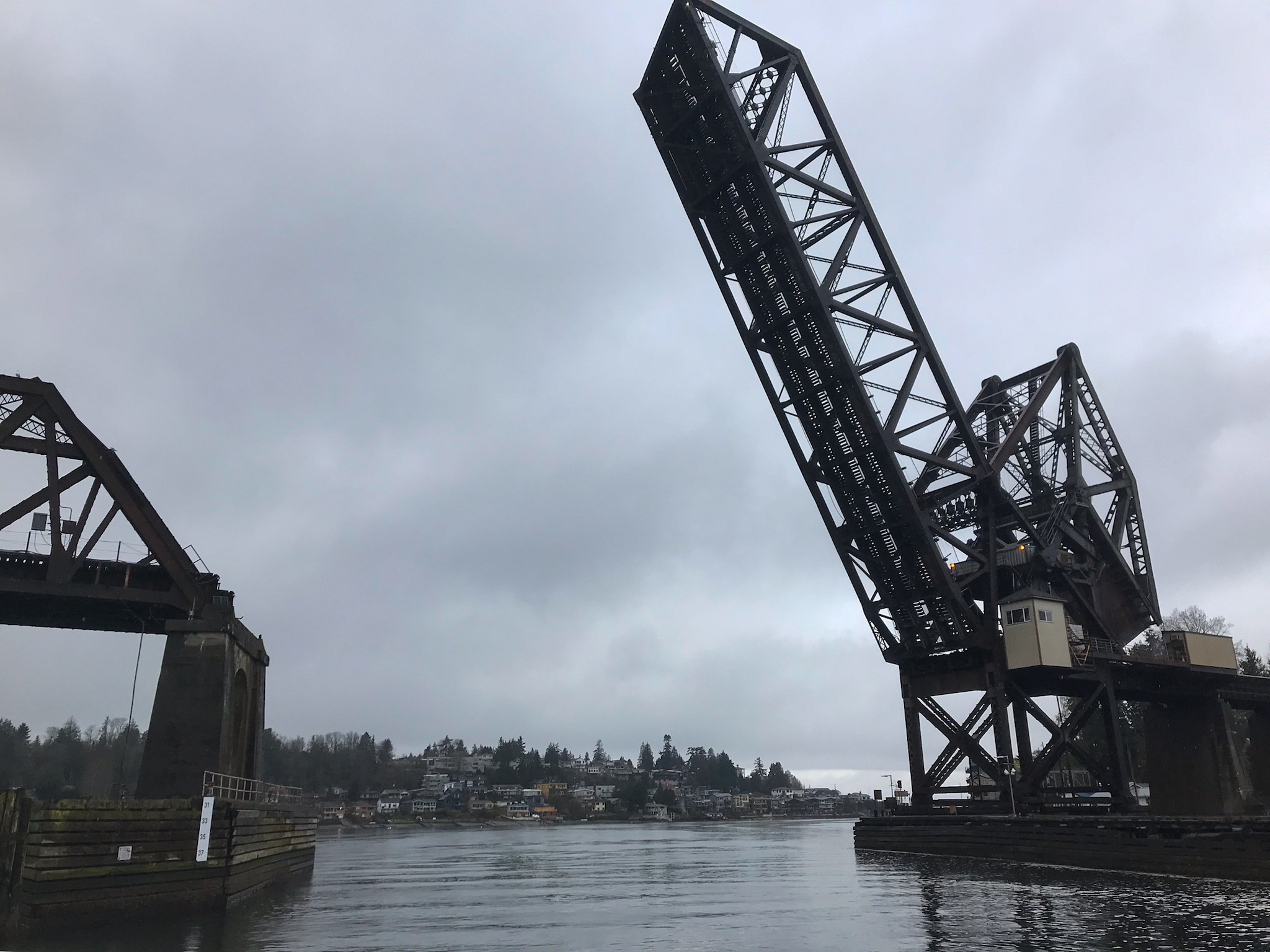
Big Locks or Small Locks?
Today was different, I was nervous. We were just about to motor past the West Point Lighthouse. We were 40 minutes from the Ballard locks. We were bringing Spice through the locks for the first time. Spice is 24 feet 5 inches wide. The locks are 26 feet or 28 feet wide, depending on whether you believe the website or the lock master I had just spoken to on the phone. The lock master assured me that wider vessels had navigated the small locks without issue, and that I could use them if I felt comfortable. I wasn’t comfortable, but the small locks are faster than the large locks.
We needed to get spice to S3 Maritime located on the Seattle ship canal for final fitting and installation of our solar arch. That meant we had to pass from the lower elevation Puget sound up into the higher elevation of the Seattle ship canal. The locks are a public and free means of moving between the Puget down to the Seattle ship canal, which connects the locks to Lake Union and Lake Washington. Gates open and close to shut boats like ours into a small space, then the water level lifts or lowers boats, depending on which way the boats are going.
Large boat exits large locks
We had to wait just on the otherwide of the rail road bridge until a large vessell cleared out of the large locks.
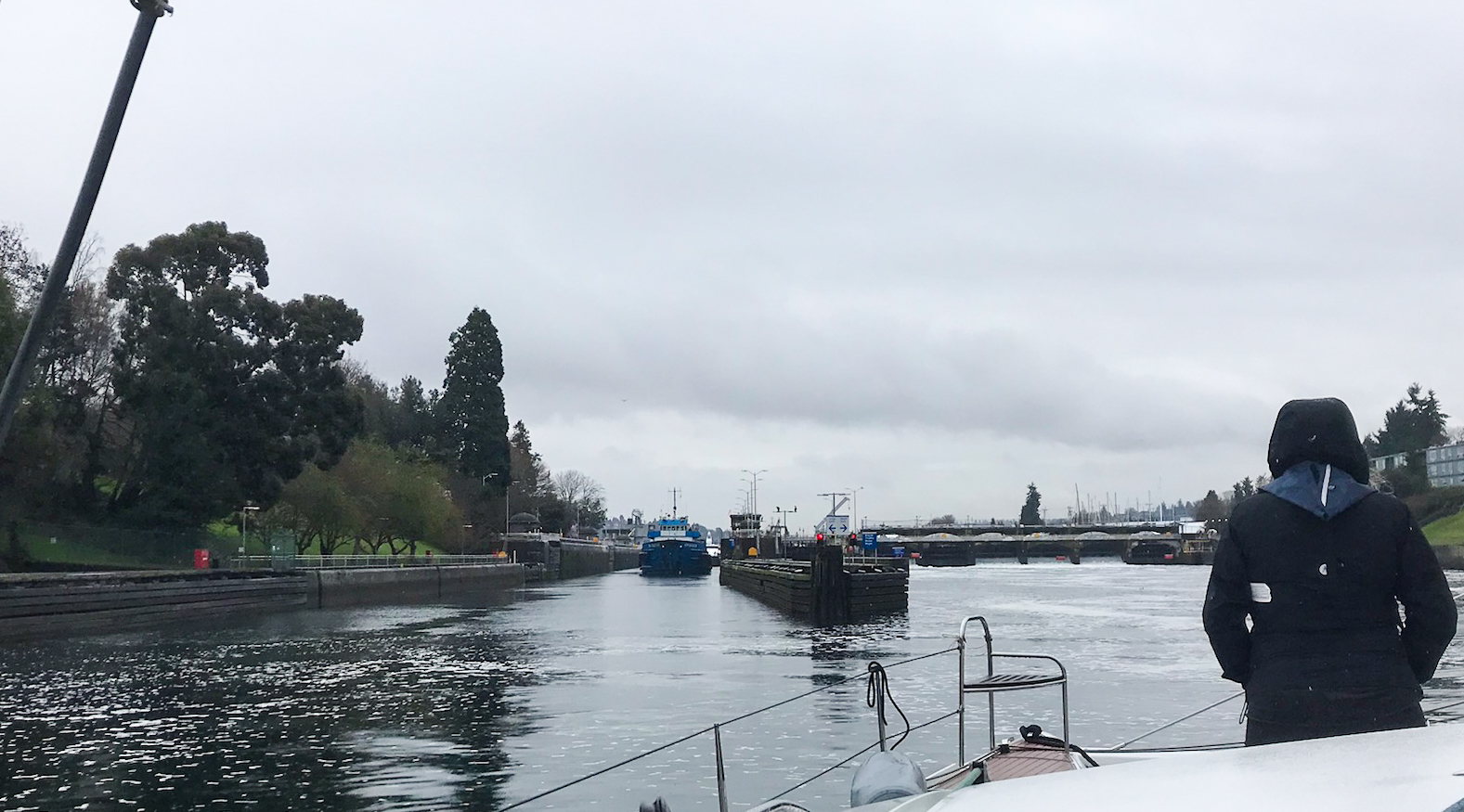
Preparing for Departure
Our story starts the day before our transit through the locks. Sarah, Lillie, Penny and I planned to spend Sunday night on Spice, the night before we needed to get Spice to S3 Maritime. Our plan was to depart Bemerton marina during a Monday 8:30 am tide window. We spent Sunday day packing up foul weather gear and delivering our car to the ballard-side, so we would have transportation once we arrived the next day by boat. Our car logistics hit a minor snag when we realized that S3 Maritime has two locations. We initially went to the remote office on the north side of the ship canal only to realize we needed to be on the other side of the canal and on the west side of the Ballard bridge. With the car moved to the correct location, we all hopped into Penny’s car to head downtown. From there we walked 1.5 miles on the water front to board the Bremerton ferry.
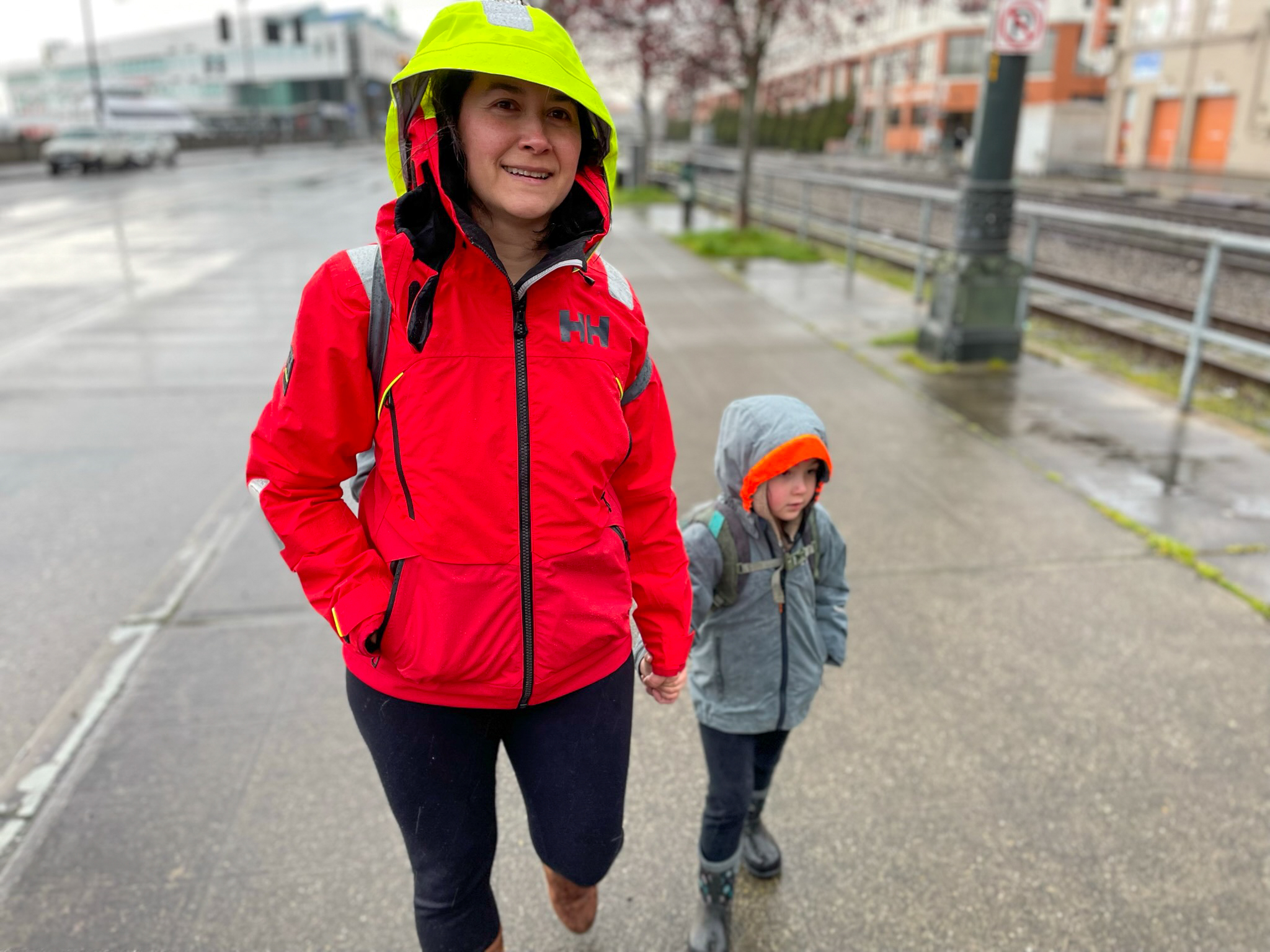
The night spent on the boat was a bit chilly, our new heater took the edge off of the cold, but didn’t keep our bed warm. The new clothes washer also made sleeping difficult. The dryer function ironically uses a lot of water, and keeps the pumps running once every 30 seconds. My and Sarah’s attempts to translate the Korean controls of the clothes washer into English in the middle of the night had failed. After those failed attempts, I flipped off the breaker to stop the drying. We finally settled in for the night.
Underway
The next morning, I double checked the tides and realized we needed to leave the dock an hour earlier than I expected. Slack current was at 8:30am instead of 9:40am. This didn’t create too much of an issue, but only because we caught the mistake. Had we waited until 9:40am, we would have had too much cross current to get out of the marina safely.
Sarah went to the coffee shop to grab breakfast. Then she topped up a water tank to the half-way point. I secured the dinghy, then started the engines. We were off. Just outside the marina, a group of sea lions went charging by. After about a mile, a large pod of small porpoises crossed 30 feet in front of our bows.
A bit later, the ferry was bearing down to pass us through the narrow Rich passage. As they approached, they gave us one blast of the horn. Last year, I took a class for a coast guard captain’s license and I knew that blast was a signal telling me how the ferry intended to pass me. At the time, I was sure that one short blast meant the ferry wanted to altercourse to port to overtake me to starboard. In response, I crossed the channel to hug the south side. Well, I got that all wrong. One blast means the opposite. The ferry had signalled they planned to alter course to their starboard to overtake me on their port side. Crap, I need more practice with rules of the road. There was no real foul, I crossed well in advance of the ferry’s overtaking and I like to think I was much more out of the way by hugging the other side of the passage.
The day was gray and misty with occasional light rain. The tempurature was tolerable with our gear. It felt great to be out in the cool breeze. There was plenty of visbility and the water was calm. There was just a bit of breeze from the south, but not enough to bother with. We motored to get to S3 Martime during its business hours.
Sarah on a gray day of boating
Both Sarah and Penny got a bit of practice at the helm, and I showed them how to use the radar and other sailing controls. Before long, we were at the railroad bridge and the Ballard locks. We had just enough fenders to put three on each side, not ideal, but it was enough. We dug out an airhorn and gave one long and one short blast to the bridge operator. They opened the bridge to let us under. Then, we waited. A large fishing boat was locking out of the large locks. Once it cleared, the small locks opened, and after the water outflow had eased, the light turned green. It was time for us to make our way in. We were the only boat.
As we made our approach, I knew our intial alignment was critical. It is not an exaggeration to say that we could end up wedged. An angle of ~10 degrees is enough to cause the bow on one side and stern on the other side to touch the walls of the locks. We don’t have bow or stern thrusters to reposition side to side, we can only control our position with a forward vector. I was nervous. I found it very difficult to guage how far away from the wall I’d end up as we made our way into the locks and as the concrete walls narrowed. Sarah called out the width from her side, still a ways from the gates of the locks. She told me we had less than 3 feet, but that were looking good. On my side, I had 4 feet, but the clearance was narrowing more and a more as we approached the gates. I was probably a bit too active on the controls, forward on port engine reverse on stabboard, no too much go back. Now, too much speed slow down, not enough speed, speed up. So far, no scratches.
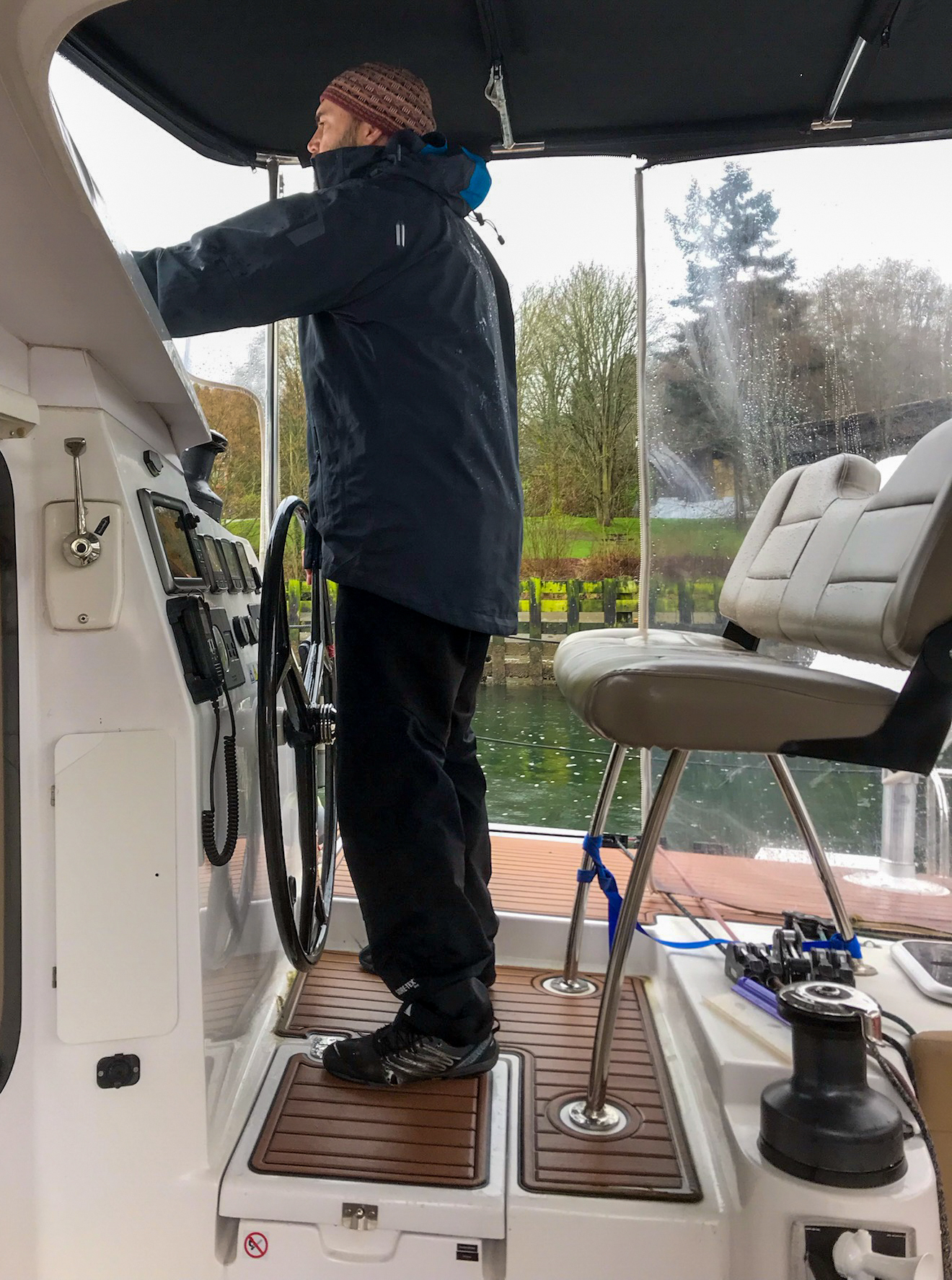
The boat only just fits
We eventually snuggled our way into position. Sarah and Penny tied us off. Depsite all of the activity in my head and my nervous hands on the controls, the external communication was calm and concise. It looked like we knew what we were doing. We were tied slightly askew. The port bow was inches from the wall, and the starboard stern was a couple feet from the wall.
All tied off, the water started to rise
A bell rings to signal closing of the gate, then the water level starts to rise. The boat is tied to floating walls. The water leaking through the gates is from the Seattle ship canal.
Into Fresh Water
With the water level almost matching the ship canal, the lake-side gates opened up. After a few minutes, we released the lines and made our way out. The port-side fenders were squeezed against the wall. We had just a few inches of clearance as we made our way out. On my side of the boat, the starboard side, we had less than 3 feet. My eyes locked onto some sharp cornered I-beams bolted to the concrete walls. Those I-beams had fenders attached, but they weren’t positioned to do anything more useful than to act as decoration. I would not like my bows to hook into any of those protrusions. We made our way slowly through the gates and the canal widened.
We made our way down the ship canal, passing large commerical tugs and fishing vessels on the Magnolia side, and industrial buildings on the Ballard side. I called S3 Maritime and they came out to the dock to greet us and provide us with docking instructions. Apparently S3 Maritime is next to the marina that always has the largest and fanciest yatchs in the canal. I was supposed to drive in between these fancy boats to a slip that was about 60 feet long, but with a concrete wall on the bow side of the slip and an expensive motor yatch at the stern side of the slip. Fortunately, there was very little wind and lots of helping hands. I eased the boat into its rather tight parallel parking spot.
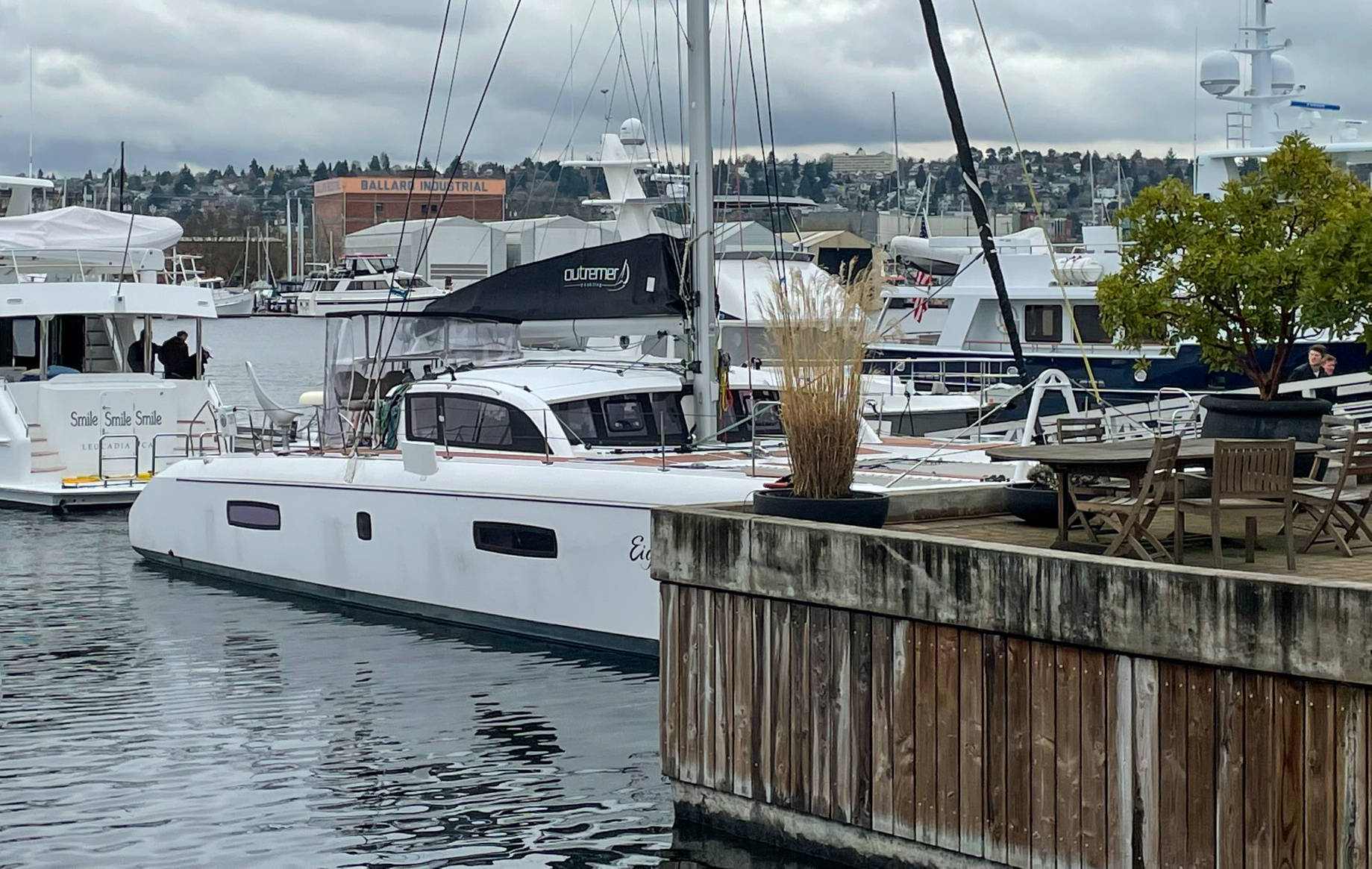
After some dock side pleasantries, our hosts offered to show us progress on the arch. Everything was looking quite nice. There just isn’t a way to make a huge solar array of four large panels look good on a sail boat, but as far as monsterous arches go, I think it looks good. S3’s workmanship was excellent. The stainless and aluminum welds were all clean, and the overall structure was sturdy. The weight was just a touch over 200 lbs for the whole setup.
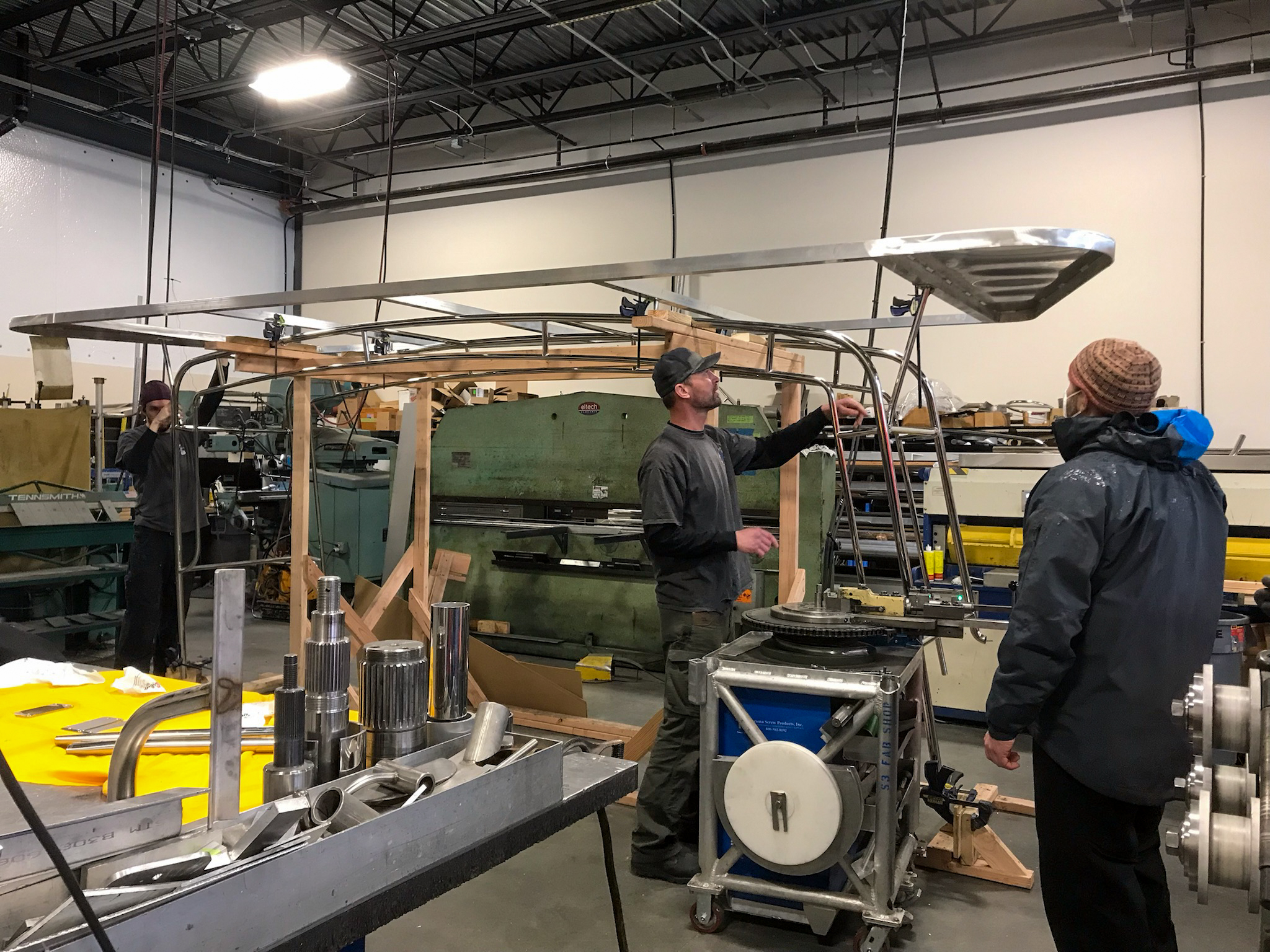
We grabbed take-out gyros and had lunch on the boat before packing up into the car and heading back to land based life. We had completed another family boat mission, and had a pleasant day on the water. With the boat in Ballard, we planned to rent a van and start the official move aboard process. Our target move on date is April 1st. This adventure is getting real very fast.
